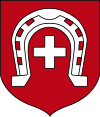Iwaniska
| Iwaniska | ||
|---|---|---|
| Village | ||

Church in Iwaniska
|
||
|
||
| Coordinates: 50°43′54″N 21°16′30″E / 50.73167°N 21.27500°E | ||
| Country |
|
|
| Voivodeship | Świętokrzyskie | |
| County | Opatów | |
| Gmina | Iwaniska | |
| Population | 1,300 | |
Iwaniska [ivaˈniska] is a village in Opatów County, Świętokrzyskie Voivodeship, in south-central Poland. It is the seat of the gmina (administrative district) called Gmina Iwaniska. It lies approximately 14 kilometres (9 mi) south-west of Opatów and 50 km (31 mi) east of the regional capital Kielce. The village has a population of 1,300, and used to be a town in 1403-1869.
Iwaniska lies on the Koprzywianka river in historic Lesser Polandthe southeastern cornerorner of the Swietokrzyskie Mountains. The village is a junction of two local roads - the 757th (Opatow - Stopnica), and the 758th, which goes to Koprzywnica. Approximately 2 kilometers southeast of Iwaniska the complex of the Krzyztopor castle is located.
The history of the village dates back to the late 13th century, when it was a settlement called Onispowka, located in feudal Poland’s Land of Sandomierz. In 1403, the influential Zborowski family decided to found town here, and at that time, Iwaniska was called Unieszow or Uneszow. The current name came into use in the mid-15th century. During the Protestant Reformation, Iwaniska was a center of Calvinism, here a synod took place in 1552, and among its participants was Jan Laski. Furthermore, Iwaniska, which belonged to the Sandomierz Voivodeship, had several artisans, with their guilds. The decline of Iwaniska was marked by the Swedish invasion of Poland; in 1656 the town was plundered and completely burned by Cossacks in service of Transilvanian prince George II Rakoczi. By 1674, the population shrank to 311, and Iwaniska never recovered from the destruction.
...
Wikipedia


